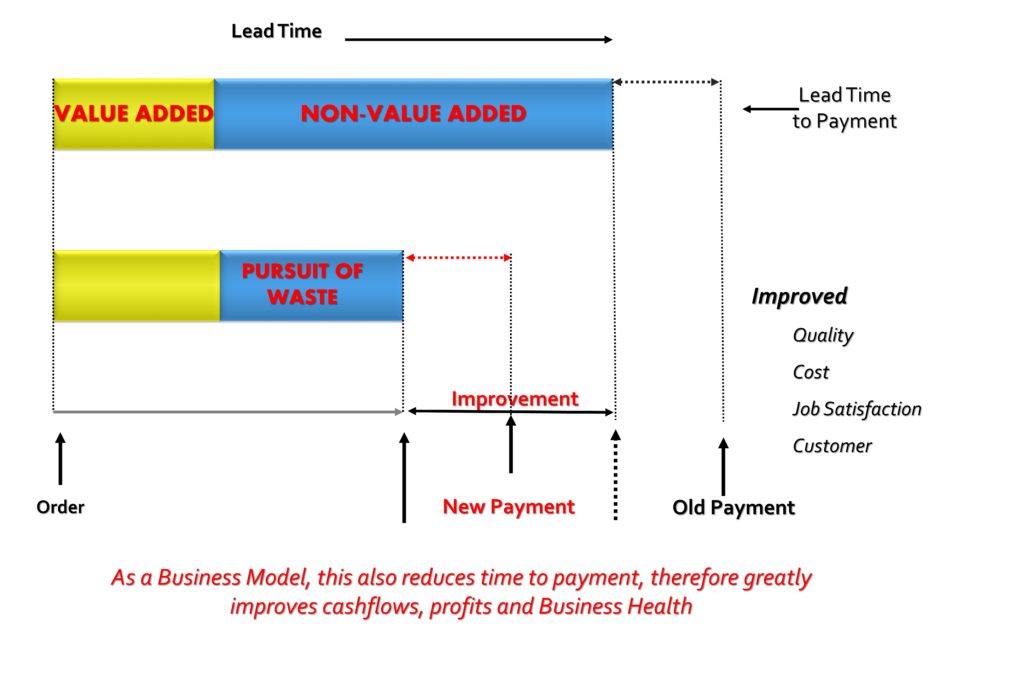In Continuous Improvement we talk about 3 different types of Value
- Value Added Activities
- Unnecessary Non Value Added Activities
- Support Activities / Necessary Non Value Added Activities
Without having to say much, they really speak for themselves and we have different strategies for them all. So lets have a look
1. Value Added Activities
So how do we know what is value added? In business we say is only that in which the customer is willing to pay for. Sounds simple yes? If only it was.
For the majority yes we can see what that value is, assembling parts on an assembly line, selling a new car to a client, a bank holding your money for you in an account. So yes we can see that.
However do you know that’s all they want?
Are you charging them the correct price for it?
Can you provide the service faster, better and cheaper?
So what’s value today may not be value tomorrow. There is a need in any business to constantly review and assess their service delivery for their clients OR you run the risk of losing clients where competition can steal your business before you know it’s gone. This happens through lack of engagement and not taking a HUGE interesting in constantly understanding what their needs are. Sometimes they may not always be able to answer that question and herein lies an opportunity to support and assist while at the same time cementing the relationship. This is where the 1st of the 5 Value Principles should be your Bible!
So, if we relate this back to the 80 – 20 Rule, this would be the 20% you need to be spending your time on. This should always be your priority. You need to meticulously understand what it is you do on a daily basis that provides value for your clients. There is no point in hitting and hoping here. Understanding ‘YOUR’ Vital Few will tell you where you need to be aligning your resources.
2. Unnecessary Non Value Added Activities
These are the things / processes your business needs to RUTHLESSLY REMOVE. The more time you are spending on these activities will lead to less time focusing on what you do need to be working on, the Value Added. Again, this may sound simple, however in reality it rarely is and in fact, not only is it not simple, this can be very well hidden and very difficult to eradicate. It takes constant and consistent efforts to understand and develop solutions to eradicate. The standard method of tackling these is to focus on removing the 8 Wastes & conduct Problem Solving. And they are the absolute correct things to focus on, however, like anything, it’s not just about the what, you need to pay special attention on the how and the why!
Enter The Human Element & Respect for people
There are 2 dimensions to delivering a successful Continuous Improvement project
Getting the staff to trust you and work with you
Then work on Continuous Improvement Improvements
Why would people want to help you? They have being working there for many years doing things a certain way. What’s in it for them? In fact some people can be very resistive in this process. They could feel betrayed by the business, stuck in a rut. So, why should they help you? To get the most effective, sustainable results through elimination of the 8 Wastes and effective Problem Solving you need to have a highly motivated team. If they are not currently motivated, a plan is required firstly to understand what motivates them and then to develop it.
Please note, that’s not to say you won’t achieve good results without this, or you need everyone on board (that rarely happens anyway), however to really achieve the full potential of a waste elimination program, that is sustainable, they need to be instrumental in this. In fact, they need to be driving it this process! This takes time, however a seed needs to be planted by you to grow this process.
Waste elimination is continuous and the more effective you work at it, the more time you will have to focus on Value adding Activities.
3. Support Activities / Necessary Non Value Added Activities
Some people call these the necessary evils, which is not reflective. While they are not adding value to the client, they ensure that the value service is feasible, carried out, in compliance and executed correctly e.g. regulatory, order processing, quality, logistics et.
They are absolutely necessary, so while you can’t eliminate them, great value is to be gained in optimising them, so you are ONLY putting the time into them that is absolutely necessary and no more!
So in short, what needs to be done is
Value Added Activities – Understand, Develop and Improve for your Client
Unnecessary Non Value Added – RUTHLESSLY ELIMINATE
Support Activities – Optmise as much as possible



